9 - Configuring Static Routing in Packet Tracer#
This tutorial is the nineth in our Cisco Packet Tracer series and focuses on static routing, a foundational technique for routing traffic between networks. Unlike RIP, where routers exchange routing tables automatically, static routes must be manually defined on each router, giving you full control over path selection.
We’ll build a three-router network, each connected to a local switch and two PCs, configure IP addressing, set up RIP on each router, and test connectivity between all endpoints.
If you’re after a different routing protocol, check out -
Find the CISCO pkt files in the repo -
Part 1 – Network Topology Overview#
This network includes:
Three routers (R1, R2, R3) connected in a linear series
Three switches (S1, S2, S3) – one per router
Two PCs per switch (6 total PCs)
The goal is to enable all PCs to communicate through manually configured static routes.
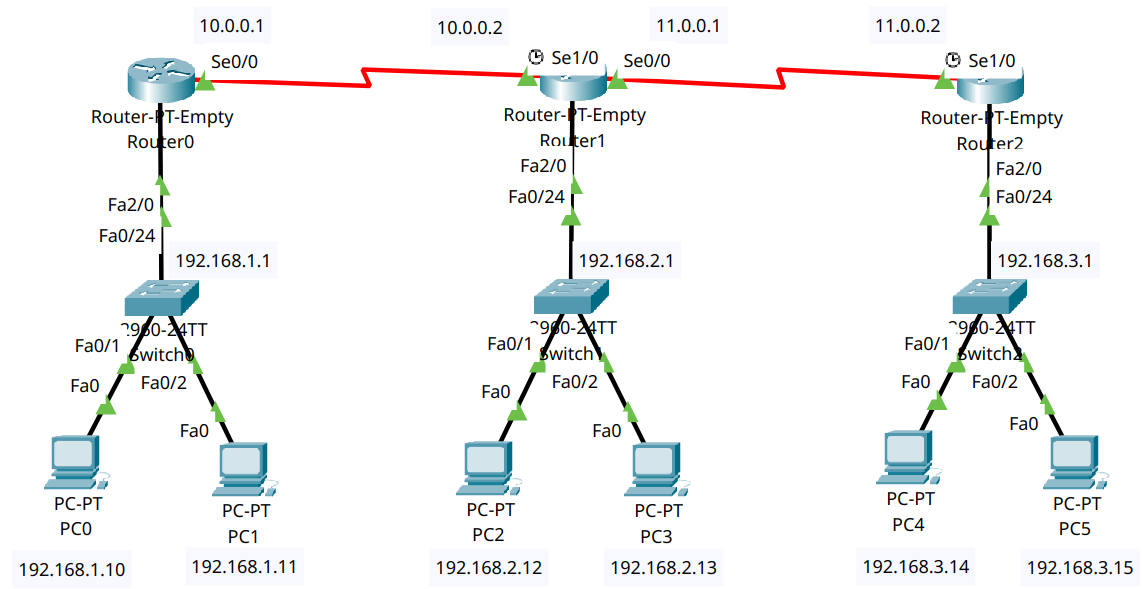
Part 2 – Device Placement and Cabling#
Step 2.1 – Add Devices to the Workspace#
Add:
3 Routers (Router-PT-Empty)
3 Switches (2960)
6 PCs
Label:
Routers: R0, R1, R2
Switches: S0, S1, S2
PCs: PC0–PC5
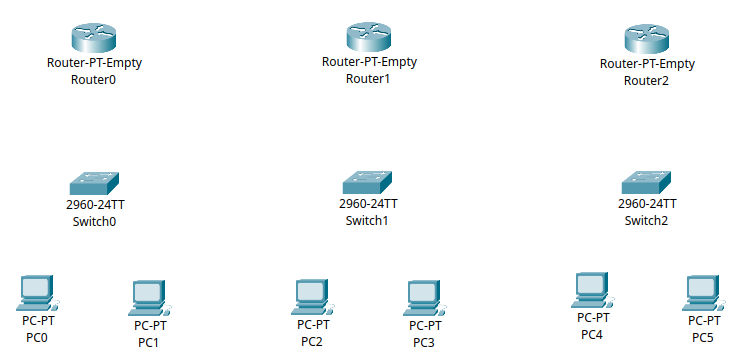
Step 2.2 – Add Network Modules to Routers#
For this topology, use Router-PT-Empty devices. Each router needs two Serial and two FastEthernet interfaces to support all required connections.
Note
We will only be using one serial and one FastEthernet interface per router for this tutorial, but the additional interfaces will allow for future expansion in subequent tutorials.
Follow these steps for R0, R1, and R2:
Click the router to open its configuration window.
Go to the Physical tab.
Click the power button to turn off the router (the green light will go out).
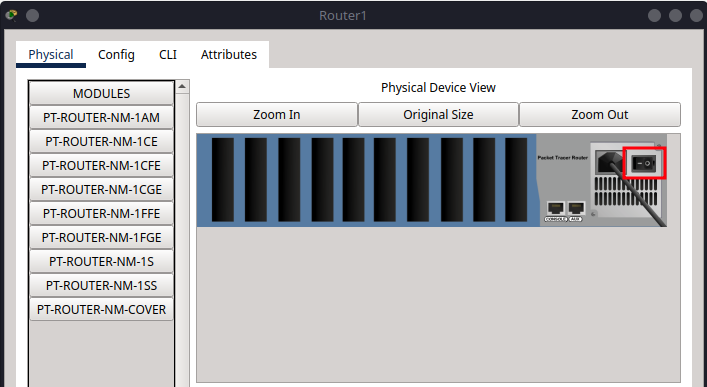
In the module area, locate PT-ROUTER-NM-1S (Serial Port) and PT-ROUTER-NM-1CFE (FastEthernet).
Drag and insert two PT-ROUTER-NM-1S modules into the first two empty slots (from right to left).
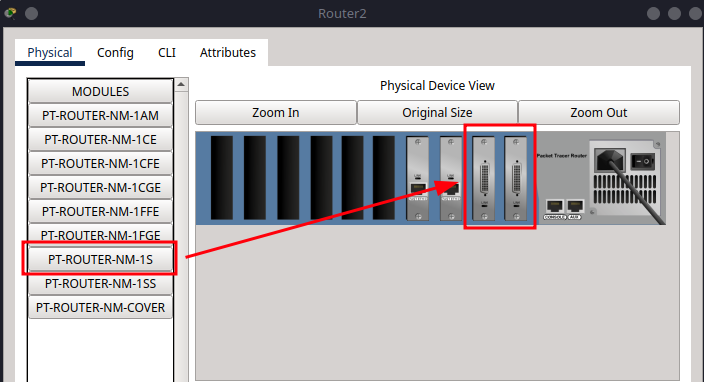
Drag and insert two PT-ROUTER-NM-1CFE modules into the next two empty slots.
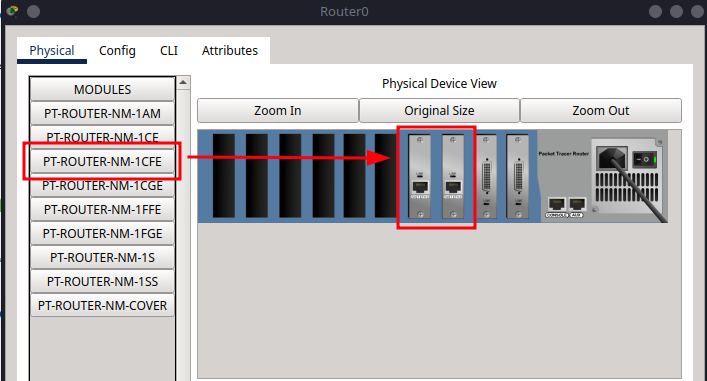
Click the power button again to turn the router back on.
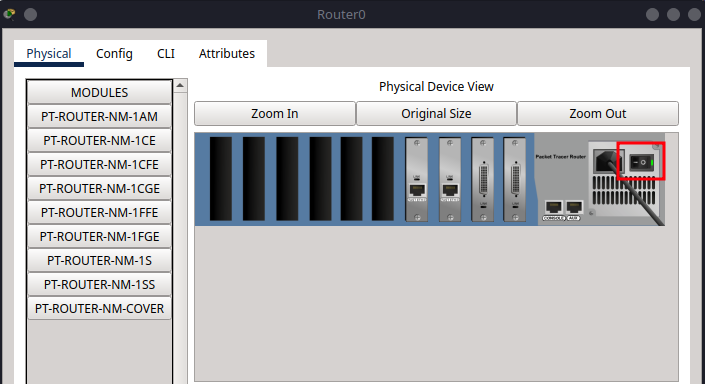
Step 2.3 – Cabling#
Copper Straight-Through#
From |
To |
Port/Interface |
|---|---|---|
PC0 |
S1 |
fa0/1 |
PC1 |
S1 |
fa0/2 |
S1 |
R0 |
fa0/24 → fa2/0 |
PC2 |
S2 |
fa0/1 |
PC3 |
S2 |
fa0/2 |
S2 |
R1 |
fa0/24 → fa2/0 |
PC4 |
S3 |
fa0/1 |
PC5 |
S3 |
fa0/2 |
S3 |
R2 |
fa0/24 → fa2/0 |
Serial DTE Connections#
From |
To |
Port/Interface |
|---|---|---|
R0 |
R1 |
se0/0 ↔ se1/0 |
R1 |
R2 |
se0/0 ↔ se1/0 |
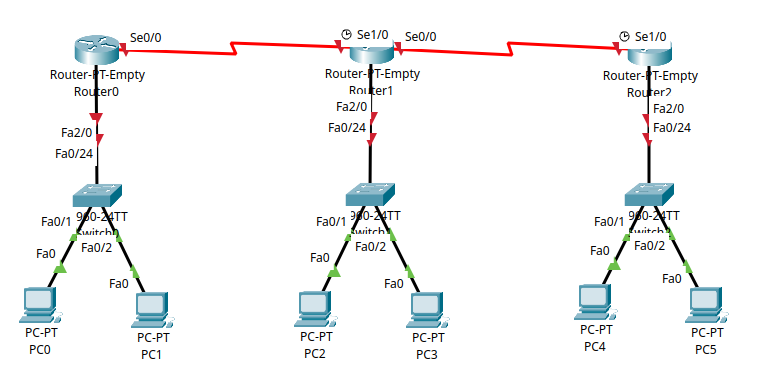
Part 3 – IP Addressing Scheme#
Now we will assign IP addresses to all devices, ensuring they can communicate across the network.
Subnet Allocation#
For this tutorial, we will use the following subnets:
Subnet |
Devices |
Subnet Mask |
|---|---|---|
192.168.1.0/24 |
PC0, PC1, R0 |
255.255.255.0 |
192.168.2.0/24 |
PC2, PC3, R1 |
255.255.255.0 |
192.168.3.0/24 |
PC4, PC5, R2 |
255.255.255.0 |
10.0.0.0/30 |
R0 ↔ R1 |
255.0.0.0 |
11.0.0.0/30 |
R1 ↔ R2 |
255.0.0.0 |
Step 3.1 – Assign IPs to PCs#
Go to Desktop > IP Configuration on each PC:
PC |
IP Address |
Subnet Mask |
Default Gateway |
|---|---|---|---|
PC0 |
192.168.1.10 |
255.255.255.0 |
192.168.1.1 |
PC1 |
192.168.1.11 |
255.255.255.0 |
192.168.1.1 |
PC2 |
192.168.2.12 |
255.255.255.0 |
192.168.2.1 |
PC3 |
192.168.2.13 |
255.255.255.0 |
192.168.2.1 |
PC4 |
192.168.3.14 |
255.255.255.0 |
192.168.3.1 |
PC5 |
192.168.3.15 |
255.255.255.0 |
192.168.3.1 |
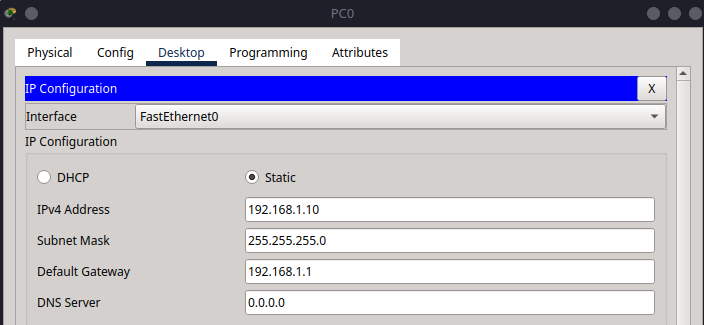
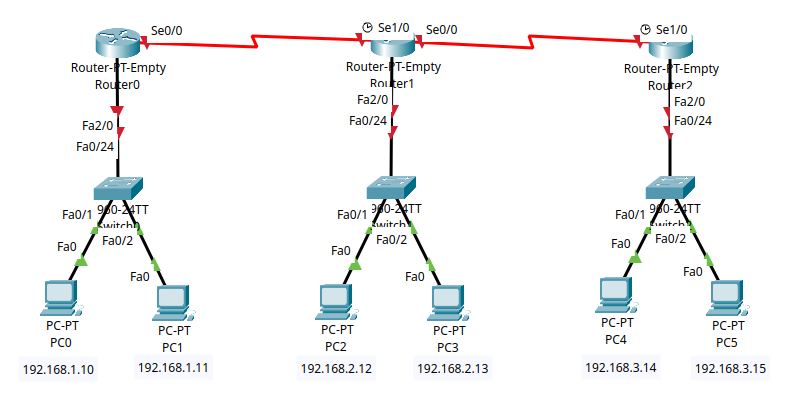
Important
Make a save of your Packet Tracer file now before you start configuring the router, we will be using this same set up in the next few tutorials as we explore different routing protocols.
Part 4 – Router Configuration#
Each router in this network handles two types of connections:
LAN-side via FastEthernet2/0, connected to a local switch
WAN-side via Serial interfaces, connected to neighbouring routers
All routers will be configured with static routing
Note
Here the static routing configuration is done manually. For example in R0, we add routes to R1 and R2 via the lines -
ip route 192.168.2.0 255.255.255.0 10.0.0.2ip route 192.168.3.0 255.255.255.0 10.0.0.2
This means that R0 will know how to reach the networks of R1 and R2 through the serial link to R1 (10.0.0.2).
Step 4.1 – R0 Configuration#
enable
configure terminal
hostname R0
interface fa2/0
ip address 192.168.1.1 255.255.255.0
no shutdown
exit
interface se0/0
ip address 10.0.0.1 255.0.0.0
clock rate 64000
no shutdown
exit
ip route 192.168.2.0 255.255.255.0 10.0.0.2
ip route 192.168.3.0 255.255.255.0 10.0.0.2
exit
write memory
exit
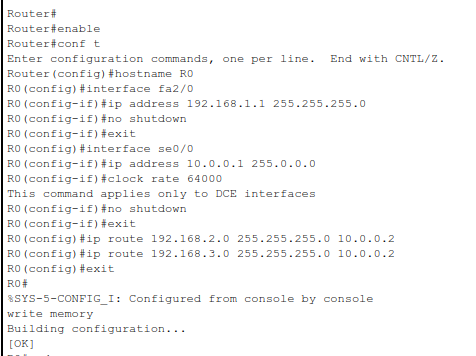
Step 4.2 – R1 Configuration#
enable
configure terminal
hostname R1
interface fa2/0
ip address 192.168.2.1 255.255.255.0
no shutdown
exit
interface se1/0
ip address 10.0.0.2 255.0.0.0
no shutdown
exit
interface se0/0
ip address 11.0.0.1 255.0.0.0
clock rate 64000
no shutdown
exit
ip route 192.168.1.0 255.255.255.0 10.0.0.1
ip route 192.168.3.0 255.255.255.0 11.0.0.2
exit
write memory
exit
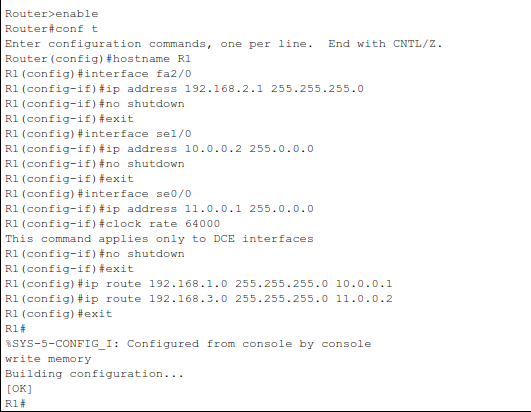
Step 4.3 – R2 Configuration#
enable
configure terminal
hostname R2
interface fa2/0
ip address 192.168.3.1 255.255.255.0
no shutdown
exit
interface se1/0
ip address 11.0.0.2 255.0.0.0
no shutdown
exit
ip route 192.168.1.0 255.255.255.0 11.0.0.1
ip route 192.168.2.0 255.255.255.0 11.0.0.1
exit
write memory
exit
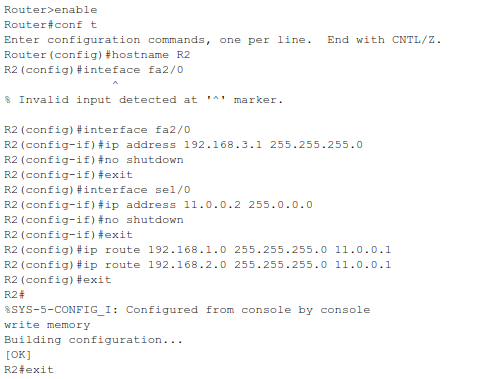
Part 5 – Verification and Testing#
Step 5.1 – Routing Table Check#
show ip route
You should see static routes (S) to remote networks.
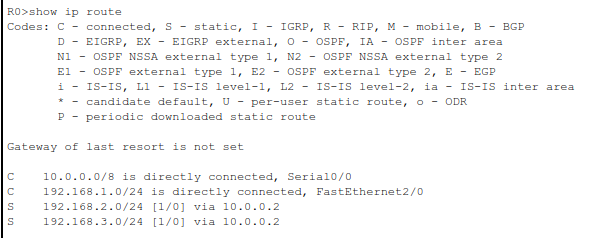
Step 5.2 – Test Connectivity#
From PC0, test:
ping 192.168.1.11
ping 192.168.2.12
ping 192.168.3.14
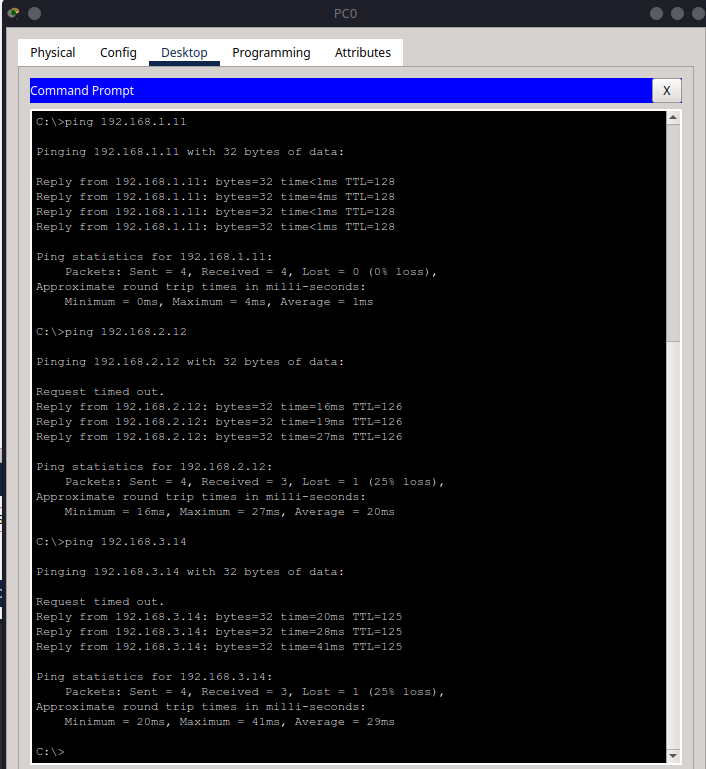
From PC3, test:
ping 192.168.3.14
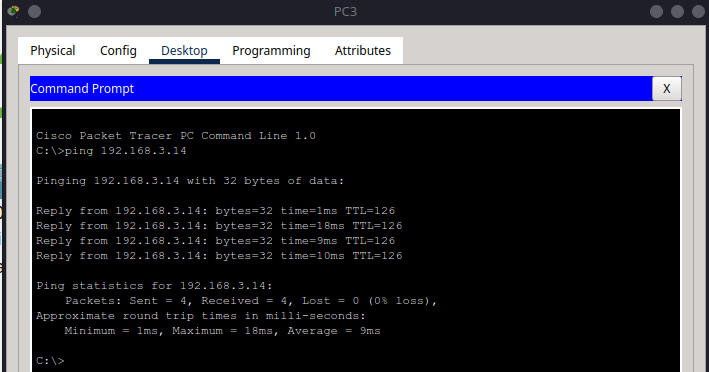
Repeat between any pair of PCs.
Summary#
In this tutorial, you:
Reused a three-router, three-switch network
Assigned IPs to all devices
Manually configured static routes
Verified end-to-end connectivity with
ping
The next tutorial will build on this foundation by introducing RIP routing, allowing routers to automatically exchange routing information and dynamically adjust to network changes.
